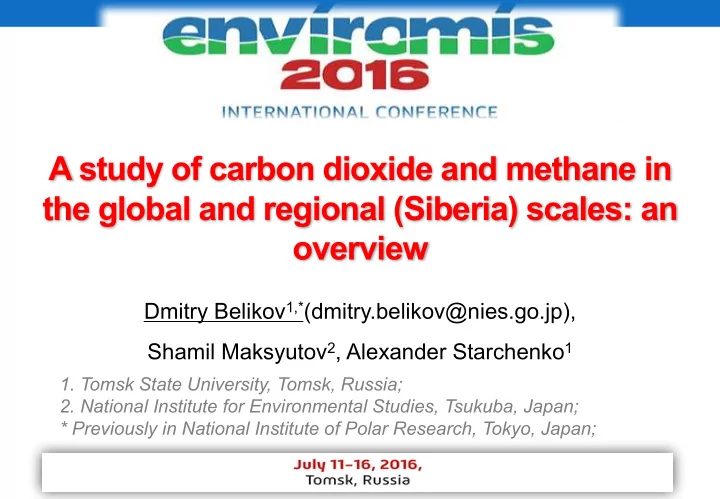

A study of carbon dioxide and methane in the global and regional (Siberia) scales: an overview Dmitry Belikov 1,* (dmitry.belikov@nies.go.jp), Shamil Maksyutov 2 , Alexander Starchenko 1 1. Tomsk State University, Tomsk, Russia; 2. National Institute for Environmental Studies, Tsukuba, Japan; * Previously in National Institute of Polar Research, Tokyo, Japan;
2 2016-07-11 ENVIROMIS-2016 CO 2 and CH 4 concentrations
3 2016-07-11 ENVIROMIS-2016 Greenhouse gases and temperature IPCC report
4 2016-07-11 ENVIROMIS-2016 Global fossil fuel emission
5 2016-07-11 ENVIROMIS-2016 NBP of Russian terrestrial ecosystems Dolman et al., 2012
6 2016-07-11 ENVIROMIS-2016 Permafrost
7 2016-07-11 ENVIROMIS-2016 Permafrost
8 2016-07-11 ENVIROMIS-2016 Spatial and Temporal Scales Discussion of Validation of each method trends in CO2 balance Atmospheric models Spatial scale Satellite TCCON FTS Tower and aircraft Tree-ring analysis Chamber Time scale Annual CO 2 Seasonal Year-to-year Trend of CO 2 budget change of CO 2 variations balance flux By Kumiko Takata
9 2016-07-11 ENVIROMIS-2016 Chamber method observations Live biomass (LB, t/ha) and net primary production (NPP, t/ha/yr) distributions in west Siberian wetlands by Peregon et al., 2008
10 2016-07-11 ENVIROMIS-2016 Tree-ring analysis (Dendrochronology) www.geography.hunter.cuny.edu
11 2016-07-11 ENVIROMIS-2016 Tower and aircraft observations
12 2016-07-11 ENVIROMIS-2016 Tower observations Aggregated Belikov et al., 2016
13 2016-07-11 ENVIROMIS-2016 Tower observations (Eddy covariance ) Dolman et al., 2012
14 2016-07-11 ENVIROMIS-2016 Land Surface models An ensemble of 8 dynamic global vegetation models (DGVMs) for geographic Russia, Belarus and Ukraine by Dolman et al., 2012
15 2016-07-11 ENVIROMIS-2016 The Total Carbon Column Observing Network (TCCON) of a network of ground-based Fourier Transform Spectrometers (FTS)
16 2016-07-11 ENVIROMIS-2016 Satellite observations
17 2016-07-11 ENVIROMIS-2016 Atmospheric models
18 2016-07-11 ENVIROMIS-2016 Eulerian-Lagrangian coupled model Tm ( ) IJ L N IJK N 1 = l ln + B n C x t , F f C f , air hNL m N r r ij ij ijk ijk = = = ij l 0 n 1 ijk n 1 CO 2 Lagrangian (LPDM) Eulerian (FLEXPART 8.0) (NIES-08.1i) Ø considers atmospheric tracers as a Ø treats the atmospheric tracers as a discrete phase and tracks each continuum on a control volume individual particle, basis; Ø better for resolving synoptic and hourly Ø effective in reproducing of long-term variations; patterns, i.e. the seasonal cycle or interhemispheric gradient; Ø running back for every observation for 48h. Ø running globally for long period. Eulerian and Lagrangian components are coupled at the time boundary in the global domain. Ganshin et al., GMD 2011
19 2016-07-11 ENVIROMIS-2016 Atmospheric models (high-resolution)
20 2016-07-11 ENVIROMIS-2016 “Top-down” Flux Inversion Estimates by David Crisp
21 2016-07-11 ENVIROMIS-2016 “Top-down” Flux Inversion Estimates The aim of the inverse problem is to find the value of a state vector x with n elements that minimizes a cost function J(x) using a least-squares method: 10.51 petaflops Ø For linear forward transport model (H), Eq. can be solved through an iterative minimization algorithm. Ø The existence of the gradient of J(x) with respect to x allows using of powerful gradient algorithms for minimization. Ø This gradient is efficiently provided by the adjoint.
22 2016-07-11 ENVIROMIS-2016 Data structure
23 2016-07-11 ENVIROMIS-2016 Multidisciplinary climate change study
24 2016-07-11 ENVIROMIS-2016 Multidisciplinary climate change study
25 2016-07-11 ENVIROMIS-2016 Multidisciplinary climate change study
26 2016-07-11 ENVIROMIS-2016 Comparison of top-down & bottom-up estimations • Monthly NEP (Bottom-up models & Tower observation) and Monthly NBP (Top-down models) Yakutsk (62N, 129E) ✔ Monthly NEP (NBP) roughly agree among the methods & models!
27 2016-07-11 ENVIROMIS-2016 Effect of including observation data in Siberia
28 2016-07-11 ENVIROMIS-2016 Summary There are various methods to study greenhouse gases emissions 1. and concentrations; These methods have different spatial and time scales; 2. Multidisciplinary projects are essential for collection and optimal 3. use of various observation data; Siberia is target region for a multidisciplinary, multiscale and 4. multicomponent research programs; Recent programs are aiming at resolving the major uncertainties 5. in Earth system science and global sustainability issues concerning the Arctic and boreal pan-Eurasian regions.
29 2016-07-11 ENVIROMIS-2016 Acknowledgments This study was performed by order of the Ministry for Education and Science of the Russian Federation No. 5.628.2014/K and was supported by The Tomsk State University Academic D.I. Mendeleev Fund Program in 2014–2015.
Recommend
More recommend